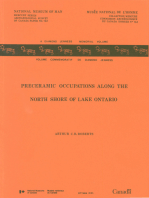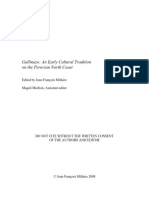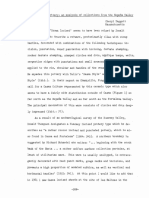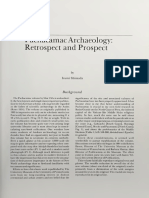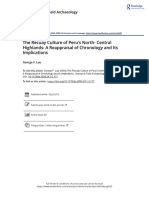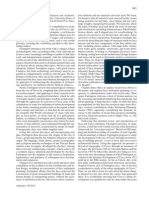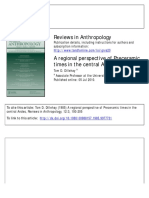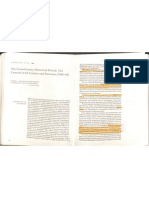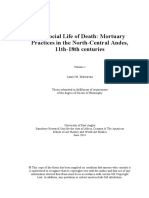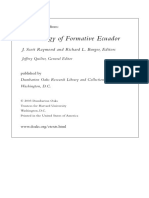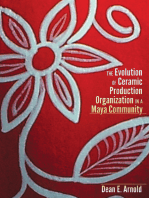Nasca Overview Zurich
Nasca Overview Zurich
Uploaded by
Paloma SantillanCopyright:
Available Formats
Nasca Overview Zurich
Nasca Overview Zurich
Uploaded by
Paloma SantillanCopyright
Available Formats
Share this document
Did you find this document useful?
Is this content inappropriate?
Copyright:
Available Formats
Nasca Overview Zurich
Nasca Overview Zurich
Uploaded by
Paloma SantillanCopyright:
Available Formats
The Nasca Culture: An Introduction
Donald A. Proulx University of Massachusetts Originally published in German in: Nasca: Geheimnisvolle Zeichen im Alten Peru, Edited by Judith Rickenbach, Pp. 59-77. Zrich: Museum Rietberg Zrich, 1999. There are no modifications to the text but the illustrations were augmented 2007. Origins During the 19th Century, examples of a new style of pottery from the New World began to appear in European museums. These ceramics were painted in a multitude of colors, sometimes displaying over 12 different tints on a single piece. A wide variety of both naturalistic as well as fantastic motifs were found on them, some clearly recognizable as birds, fish, plants and animals (Fig. 1), but others portraying strange creatures exhibiting both human and animal characteristics. These motifs were painted on a variety of different shapes: bowls, jars, cups, and bottles with double spouts connected by a flat handle. There were also modeled or effigy vessels in the form of humans, plants, animals, and the same mysterious creatures seen on the painted versions. The source of this pottery was the South American country of Peru. There were no professional archaeologists working in that region at this early date, and collections were made by local land owners or foreign professionals working in Peru. One such collection was formed by a Peruvian Physician, Jos Mariano Macedo, who, following the Chilean occupation of Lima in 1881, took his collection to Europe and sold it Fig. 1 to the Ethnographic Museum of Berlin in 1886 (Chavez 1979:220). The German textile merchant Christian Theodor Wilhelm Gretzer, who lived in Lima between 1872 and 1903, acquired a large collection which eventually was divided between the museums of Berlin, Hannover and Hildesheim (Raddatz 1985:1). These and many other private collections were the foundation for the Pre-Columbian collections in most European museums. The polychrome painted ceramics described above were present in limited numbers in some of these early collections, but their exact source remained a mystery. Few accurate records were made by the early antiquarians whose interest lay in the aesthetic value of the pieces rather than in their origins. The German-born archaeologist Max Uhle (Fig. 2) was working at the Museum fr Vlkerkunde in Berlin in the 1880's when he first saw several examples of this exquisite pottery. These pieces were part of the Macedo Collection which had been acquired by the museum. Fascinated by the beauty of this pottery, Uhle began a decade-long quest to discover the source of these 1
ceramics. His travels took him to various South American countries where he collected ethnographic and archaeological specimens for the Berlin museum and later for the University of Pennsylvania Museum. In February of the year 1901, Uhle realized his goal when he became the first person to scientifically excavate cemeteries containing this polychrome style of pottery (Proulx 1970; Rowe 1944)). The location of these ancient graves was along the barren desert borders of the Hacienda Ocucaje in the lower Ica Valley on the south coast of Peru. At the time he was working for the University of California at Berkeley under the sponsorship of Mrs. Pheobe Apperson Hearst. In all, Uhle excavated and Fig. 2 documented 31 graves containing 147 Nasca vessels which are now available for study in Berkeley (Proulx 1970; 1968). He initially called this pottery the "new-found style of Ica"; in later publications he referred to it as "Proto-Nasca" and then finally as "Nasca." In October of 1905 Uhle stopped briefly in the Nasca Valley and acquired an additional 660 Nasca ceramic vessels, most likely purchasing them from huaqueros (grave robbers), for there is no evidence that he carried out any excavations while he was there (Gayton and Kroeber 1927:2-4). Since that time many other archaeologists working in these south coast valleys have contributed greatly to our knowledge of this ancient civilization. The name Nasca was applied to this culture as early as 1912 by Thomas Joyce who, along with others, believed the Ro Grande de Nasca drainage to be the center of this civilization (Joyce 1912). Recent studies have yet to clarify its exact place of origin, but the lower Ica Valley now seems to be as likely a source as the Nasca drainage. It is clear that Nasca is closely related to the earlier Paracas Culture (900-200 B.C.) which was centered in the Pisco and Ica valleys, including the Paracas Peninsula where the famous Paracas Necropolis was located. In essence, Nasca is merely a continuation of Paracas Culture including the same religious tradition, weaving technology, and general way of life. The decision by archaeologists to recognize a new culture which we call "Nasca" was based on rather arbitrary criteria. Around 200 B.C. the Paracas people began experimenting with a new type of pottery decoration called slip painting. Previously pottery was decorated after firing with paints derived from various sources. The pigments were thick and friable because they were not baked on to the vessel surfaces during the firing process. Slip paints, on the other hand, are made from powdered mineral sources, mixed in a clay slip, and applied to the pottery before firing. These pigments not only produce a new range of colors not available with plant pigments, but were fused to the vessels during firing. Along with the innovation of slip paints, was the shift in religious iconography from the elaborate textiles of the Paracas period to the polychrome painted pottery of the Nasca Culture. Through time the Nasca Culture continued to evolve and develop its own distinctive character, but its roots in the Paracas tradition have been clearly established.
Distribution and Chronology The Nasca Culture emerged during the Early Intermediate Period (100 B.C. to 650 A.D.) and was centered in the Ica and Nasca valleys of south coastal Peru (Fig. 1) Over time it's influence was felt in a territory ranging from the Caete Valley in the north to the Acar Valley on the south and up into the Ayacucho area in the highlands. There is no evidence for actual colonization or military expansion into these outlying areas; the influence was in the form of prestige or trade. Recently, Nasca cultural materials have been found in cemeteries at Ocoa, Caman and in the Sihuas Valley in the Department of Arequipa. These also appear to be trade items. In an attempt to maintain better chronological control over the 800 year time span of the Nasca Culture, archaeologists have sub-divided the Early Intermediate Period in a variety of ways. The most frequently used chronological scheme is based on a ceramic seriation which was proposed by Lawrence E. Dawson of the Museum of Anthropology at the University of California, Berkeley in the 1950's. Fig. 3 Nasca Chronology PERIODS ESTIMATED DATES STYLISTIC STRAINS DAWSON'S PHASES 9 Disjunctive 650 A.D. 550 A.D. Proliferous 425 A.D. EARLY INTERMEDIATE PERIOD 300 A.D. Transitional 6 5 Middle Nasca 175 A.D. 50 A.D. 75 B.C. 100 B.C. Monumental 4 3 2 Proto-Nasca 1 Early Nasca 8 7 Late Nasca Nasca-Wari SAWYER'S PHASES
MIDDLE HORIZON
Using scientifically excavated gravelots (all the artifacts in a single grave) from a variety of Nasca period sites, Dawson studied the correlations of minute changes in shape and design elements present within his sample. This type of seriation is qualitative rather than quantitative. In other words, the presence or absence of a particular trait at a point in time is more important that its frequency in the sample. Gravelots are an ideal medium with which to test cultural change, since all of the ceramic vessels contained in a burial are considered to be contemporary. As such, gravelots should reflect the range of variability in shapes and designs present at a particular point in time, and these patterns can be compared to those in other gravelots, thus allowing a sequence to be established. Based on this procedure, a sequence of 9 phases of the Nasca style was established (Fig.3). In this scheme, Phase 1 represents a transition between the earlier Paracas pottery tradition and the slip painted Nasca style. Some authors have referred to this phase as "Proto-Nasca." Phases 2 through 4 are characterized by mostly naturalistic themes, both secular (such as birds, plants, fish) and mythical. These three phases are sometimes referred to as "Early" or "Monumental" Nasca. Phase 5 was a time of great innovation and change, including the beginning of "proliferous" elements in the art. The term proliferous refers to the addition of rays, tassels, and volutes to designs which in turn became more abstract and geometricized. Phase 5 is a transitional phase linking the naturalistic strain to the proliferous and is called "Middle Nasca" by some scholars. Phases 6 and 7 (Late Nasca) mark the high point of the proliferous strain and the end of the Nasca sequence in the Early Intermediate Period. The Nasca style continues into the Middle Horizon (600-1000 A.D.) in Phases 8 and 9 which are called "disjunctive" and are characterized by a radical abbreviation of stylistic elements into abstract geometric forms as well as the introduction of outside elements from the emerging Huari Culture of the highlands (see Silverman 1993, Chapter 3 fo4r an illustrated overview of the sequence). Geographic Setting The south coast of Peru is an arid sub-tropical desert with annual precipitation ranging from zero to 25 millimeters (Fig. 4). The climate is controlled by the cold Humboldt Current of the Pacific Ocean which prevents rain from reaching the warm littoral zone. Temperatures range between 10 and 32 C, averaging 21C on an annual basis. During the winter months (June, July and August), fog banks extend inland from the ocean, helping to hold temperatures down. Summers are sunny, dry and very hot. At periodic intervals, a warm mass of water migrates across the Pacific Ocean displacing the cold waters of the Humboldt Current. This is known as an El Nio event, and the effects include torrential rains and flash flooding along parts of the coast and drought conditions elsewhere. In 1998 Peru was affected by one of the worst El Nio's in over 500 years. The resulting damage affected not only the modern populations, but caused much harm to the archaeological sites of the area. The Nasca people were concentrated in the Rio Grande de Nasca drainage which incorporates 9 separate tributaries covering an area of about 10,750 square kilometers (Silverman 1993:1). These tributaries, with names such as Ingenio, Palpa, Aja, Tierras Blancas and Taruga, extend high into the Andes where they collect the summer rains an 4
water from melting glaciers to provide sustenance for the Nasca people especially during the winter months of January to March (Fig. 4). To the north is the Ica Valley, unusual in its configuration in having no major tributaries and flowing in a general northsouth pattern. Although the mouths of the Ica and Nasca rivers are only 25 kilometers apart, the two systems diverge inland leaving a vast expanse of desert separating their middle and upper segments. Any contact between the valleys in the past most likely occurred in the lower portions of the valleys (Figs. 5 and 6).
Fig. 4
Fig. 5 5
Fig. 6
Subsistence The Nasca people practiced intensive agriculture in a precarious area characterized by unpredictable natural events such as frequent droughts, earthquakes and flash flooding. The need for water affected their entire lifestyle and played a major role in the form and practice of their religion. The alluvial soils were ideal for the growing of corn (Zea mays), the common bean (Phaseolus vulgaris), lima beans (Phaseolus lunatus), manioc (Manihot esculenta), potato (Solanum spp.), sweet potato (Iopmoea batatas), Achira (Canna spp.), squash (Cucurbita maxima), peanuts (Arachis hypogaea), Lcuma (Lucuma bifera), Guayaba (Psidium guajava), Pacae (Inga feuillei), Palta (Persae americana), Jquima (Pachrrhizus tuberosus), and peppers (Capsicum spp.) among others. They also exploited the cold waters of the Pacific Ocean hunting mammals such as seals and otters, using nets to obtain corvina, coco, anaque, and other local species of fish, collecting shellfish and mollusks, and acquiring other products of the sea. Non-edible plants such as cotton, cane, totora reeds, gourds and junco were used for utilitarian purposes. Domestic animals such as the llama and alpaca had been imported from the highlands at an earlier time and were present in Nasca society as was the Guinea Pig (Cavia porcellus) which was used in ritual and as a ritual food. 6
Physical Appearance and Occupations The physical appearance, clothing and ornaments worn by the Nasca can be reconstructed from pottery representations and from the bodies and artifacts found in their tombs. The overwhelming majority of male depictions fall into two major occupational/social categories: farmers and warriors. Early Nasca farmers are very naturalistic in their depiction either holding plants or agricultural diggings sticks in their hands. These individuals wear minimal clothing, often only a loin cloth and a distinctive conical cap with flap extending down over the back of the neck (Fig. 7). In the hot desert climate of the south coast of Peru, it is not surprising to find near-naked agriculturalists toiling under the hot sun. Warriors form the other major category of male representations in Nasca ceramic art. Early warriors are nearly always depicted in a frontal, full-face manner displaying facial painting and holding weapons in their hands. These individuals are more elaborately clothed than farmers, wearing a tunic on the upper portion of the body along with the traditional loin cloth. Headdresses Fig. 7 range from slings wound around the head in turban-like fashion seen on modeled vessels to more standardized caps portrayed on the painted types. Weapons include clubs, spears and atl atl's, bolas and slings (Fig 8A). By Phase 5 warriors painted in profile become the dominant type. These figures exhibit many of the same characteristics as earlier warriors with several exceptions. Military paraphernalia becomes more and more elaborate through time. Feather staffs and elaborate clothing mark the later phases (Fig. 8B).
Fig. 8A and 8B
Curiously, depictions of women are absent in Nasca art until Phase 5 when they suddenly become a major theme. Since the representation of genitalia and breasts only appear on naked figurines in Nasca art, identification of the sex of an individual depends on secondary evidence such as clothing, hair style and occupation; in some cases it is impossible to ascertain the gender of an individual. Women wore their hair longer than men and are portrayed with long tresses reaching midway down the back while in the front the hair frames the face and falls part way down the breast on either side. The main item of clothing worn by females is an ankle length mantle which is most often shown wrapped around the body, sometimes fastened with a pin (Fig. 9). When drawn on a ceramic vessel, these mantles served as the background for mythical Fig. 9 creatures who are drawn on top of them. Beneath the mantles women to have worn a long tunic with fringed sleeves, probably consisting of two rectangles of cloth sewn together to form the garment. The major difference between male and female tunics is the length, some of the later female examples extending to the ankles. Nasca ceramics give few clues as to the range of women's activities in this society. There are a number of modeled Nasca vessels graphically depicting scenes of childbirth. Erotic scenes are also present in the art, but are much rarer than in contemporary Moche art and indeed may reflect influence from the Moche area in the latter part of the sequence. Other modeled vessels have rare depictions of women carrying burdens on their backs, leading llamas by ropes, and either cooking or preparing chicha in a group. It is interesting that no family groups are seen in the art, no children, nor do we see activities such as weaving or ceramic production. Although women most likely played as important a role as men in agricultural activities, the ceramic art tells us nothing. Although females may be depicted with facial painting, the majority are not. Males, to the contrary, frequently display a wide variety of painted facial designs especially among warriors. On the other hand, women commonly display tattoos on their arms, and in the case of figurines, on their thighs, buttocks, and surrounding the genital area. Most of these tattoos are of supernatural themes such as killer whales, rayed faces, etc. (Fig. 10) Women's faces may also be the locus of tattoos, but this is more common on males who are less likely to Fig. 10
have these designs elsewhere on their bodies other than the arms and face. Actual tattoos have been preserved on the arms of mummified bodies found in Nasca tombs. Men may also sport facial hair in the form of mustaches and/or a small goatee, but facial hair is on average relatively sparse on American Indians, and most individuals do not have this characteristic. Both sexes wore earrings, square or rectangular in shape, perhaps made of Spondylus shell, and attached to the earlobes with loops of string (Fig. 11). It is interesting that males in Nasca society do not wear ear spools as a sign of rank like many of the other cultures of ancient Peru. Men wore necklaces composed of rectangular pieces of Spondylus shell (these have been found archaeologically in tombs), and the presence of gold mouth masks and forehead ornaments in museum collections argues for some males wearing these symbols of religious deference. Shell pectorals are sometimes Fig. 11 depicted on the chests of individuals of both sexes, but other jewelry is rare. Males have a much wider range of headgear than females, and these apparently reflect the occupation of the wearer as either a warrior, farmer, fisherman, or shaman. Tassels, feathers and other appendages are often seen attached to these head pieces. In Phase 7 some males are illustrated holding a "fly swatter-like implement" in the right hand, perhaps as some indicator of rank. Skull deformation was a common practice in Nasca society, perhaps as an indicator of rank. The most common variety was occipital and frontal flattening produced by binding boards to the head of an infant shortly after birth. The result was an elongated "loaf-shaped" head that is often found in burials or reflected artistically in Nasca figurines (Fig. 12).
Fig. 12 Settlement Patterns Our knowledge of Nasca settlement patterns has been expanded by recent systematic archaeological surveys of the Rio Nasca and its tributaries the Rio Aja and Rio Tierras Blancas as well as the Taruga and Las Trancas tributaries by Katharina Schreiber, the Rio Ingenio by Helaine Silverman, the Rio Palpa by David Browne, and the littoral zone by Patrick Carmichael. In addition, Sarah Massey has surveyed the upper Ica River valley and Anita Cook has completed a survey of the lower Ica Valley. In Acar, Francis 9
Riddell and his colleagues from the California Institute for Peruvian Studies, are working on a survey of that region. Unfortunately the data from these surveys is still undergoing analysis, and no complete settlement pattern report has yet been published by any of these investigators except for a few preliminary accounts. Until this occurs, even a basic knowledge of the nature and distribution of Nasca settlements remains elusive. Despite these qualifications, a few notes about Nasca settlements can be made. In the Rio Grande de Nasca drainage, the majority of the Nasca period settlements are located well inland, along the flanks of the tributary rivers. Although Carmichael (1991) has argued for a lack of Nasca sites in the littoral zone, recent work by Anita Cook in the lower Ica Valley has revealed a continuous Nasca occupation in that valley from the mouth of the river inland (Cook 1994). A Nasca presence, or at the least Nasca influence, is found in the Acar Valley at Tambo Viejo, Chavia, La Oroya, Gentilar, Coquimbo, Cancino Alto A and B, Monte Grande Alto, Boca del Rio, Amato and Huarato Riddell and Valdez 1988). To the north, in the Pisco Valley, pure Nasca style pottery has been reported at Tambo Viejo and possibly Dos Palmos, and a Nasca influenced style known as Carmen, is widespread in the valley (Panion 1997). In the Caete Valley, at the site of Cerro del Oro, Nasca style pottery was recorded by Kroeber (1937). The heartland of the Nasca Culture, however, was centered in the Ica and Nasca drainages. Among the largest known Nasca sites is Cahuachi located at an elevation of 365 meters above sea level on the southern bank of the Rio Nasca. The water table is shallow in the vicinity of the site with permanent seepage on the surface, a factor that was important in determining the location of the site (Silverman 1993:1112). It is also adjacent to the Pampa de San Jos which contains a large number of ground drawings or geoglyphs, and this relationship also does not seem to be coincidental.
Fig. 13
10
Cahuachi covers an area of 150 hectares, but its monumental architecture is concentrated in an area of 25 hectares located near the center of the site (Silverman 1993:57). Some forty mounds comprise the core of the site along with three and four sided enclosures (Fig. 13). The mounds were fashioned by modifying natural hills found on the ancient river terraces; a few were augmented or enlarged with artificial adobe construction. All mounds were truncated or had platforms on their summits. Some mounds were used for burials while others supported construction which had a ritual function. The areas between the mounds consisted of bounded open spaces referred to by Silverman as "kanchas" (ibid.:89). Cahuachi was once thought to be a major urban center, the capital of a primitive regional state (Strong 1957; Rowe 1963; Proulx 1968). Recent excavations by Silverman (1993) and Orefici (1993) have demonstrated that the site was an empty ceremonial center which apparently served as a place of pilgrimage and burial until Nasca Phase 5, after which it became a mortuary area and place of offerings. Silverman (1990) has argued that some of the "Nasca Lines" or geoglyphs in the Pampa de San Jos may connect Cahuachi to the urban settlement of Ventilla in the Ingenio tributary. Ritual offerings, such as those found in the "room of the posts" by Silverman (1987) suggest a long usage of the site with continuation of burials into the Middle Horizon Nasca Phase 8. Orefici (1996) has also traced the beginnings of occupation at the site to the late Paracas Phase 10 and early Nasca Phase 1 periods. According to Helaine Silverman, one of the largest Nasca urban centers lies directly across the Pampa de San Jos from Cahuachi on the flanks of the Ingenio River tributary. Named Ventilla, the site extends along the side of the valley for close to 4 kilometers and covers an area of 200 hectares. The site consists of hundreds of habitation terraces containing the remains of densely agglutinated houses, some large enclosures, and a few artificial mounds (Silverman 1990:439). The site appears to have been connected to Cahuachi by a linear path or geoglyph running across the pampa and perhaps serving as a ceremonial road for pilgrimages between Ventilla and the ceremonial site. Silverman has also argued that Ventilla and Cahuachi may have served as "dual capitals of early Nasca society", one secular and the other religious (Silverman 1993:326). This hypothesis seems less credible in light of recent speculation on the nature of Nasca political structure. Other scholars who have visited Ventilla dispute Silverman's claim that it is an urban center, pointing out that not only is it multi-occupational and therefore does not belong entirely to the Nasca period, but that the structures are small and ill defined (Valdez 1998). The true nature of Ventilla must wait until excavation of the site is undertaken. The lack of major urban centers is one of the most puzzling aspects of Nasca society. The vast majority of Nasca domestic sites appear to be small villages or hamlets measuring under two hectares in size (Fig. 14). In the upper tributaries, houses were constructed on artificial stone terraces carved onto the slopes of the hills flanking the valley. Near the sandy pampas, houses were constructed of wattle and daub, i.e. a framework of poles and matting that was covered with a clay plaster. The use of adobe bricks is also found in some of the constructions. Few domestic structures have been 11
scientifically unearthed. Kevin Vaughn is currently excavating a typical early Nasca habitation site at Marcaya in the Tierras Blancas tributary, and the results of his work should prove valuable in defining the nature of Nasca domestic sites. The construction material at this site appears to be fieldstone rather than more perishable material, but the form of the individual structures and the layout of the village will not be determined until the work is complete and published. Much additional work of this type needs to be performed on the south coast before an adequate picture of Nasca life emerges. From the surveys undertaken, it is clear that the distribution of sites changed from one phase to another during the 800 year long sequence. David Browne's survey in the Palpa region suggests that Fig. 14 there was a major expansion into that area during Nasca Phase 1 with a visible hierarchy of sites (Browne 1992:77). By Nasca Phase 3 civic and ceremonial centers were fully developed and part of the hierarchy. However, major changes occurred in Phase 5 when many of the civic and ceremonial centers wer abandoned and thereafter used for burial purposes. This pattern was also evident at Cahuachi and other sites in the Rio Nasca tributary. The cause of this shift may have been the onset of a major drought that occurred between A.D. 540 and 560 and again between A.D. 570 and 610 (Schreiber and Lancho 1995:251). The drought apparently stimulated the construction of wells and filtration galleries called "puquios" which were located mainly in the middle part of the valley. Population shifts resulted, with new sites being established in the mid valley to take advantage of the new sources of water, while in other areas the people appear to have been consolidated into larger settlements. The last phases of the Nasca sequence witness a major decrease in population and in the number of sites. Weakened by these natural disasters and other factors, the Nasca eventually succumbed to more powerful forces emanating from the highlands.
Socio-Political Organization Our perception of the political organization of the Nasca people has vacillated over the past few decades. It was once thought that the Nasca controlled a primitive state level society with a strong central government centered at the large site of Cahuachi (Strong 1957; Rowe 1963; Proulx 1968). The striking homogeneity of the pottery found 12
in the Ro Grande de Nasca drainage and in the Ica Valley, especially during Phase 3, suggested a strong central control (Proulx 1968). The sudden appearance of Nasca pottery in peripheral valleys, at sites such as Tambo Viejo in Acar and Tambo Colorado in Pisco, indicated a possible military conquest of these regions by this same central authority. This picture changed dramatically due to the work of Helaine Silverman and Giuseppe Orefici at Cahuachi. Silverman's excavations demonstrated that Cahuachi was an empty ceremonial center that had few permanent inhabitants, and was not a thriving city (Silverman 1993). Similarly, Orefici's excavations over a period of many years also failed to discover any evidence of domestic activity (Orefici 1993). At the same time, Lidio Valdez, working in the Acar Valley, has argued convincingly that there is no evidence for a Nasca invasion and colonization of this valley. The few Nasca ceramics found at Tambo Viejo and other Acar sites can be explained as trade items. The same can be said for the role of Nasca in the Pisco Valley. There appears to be no strong evidence for invasion or colonization of that valley either, although Nasca presence can be seen in its prestige influence on local pottery styles and presumably in religious practices. Based on this new data, it seems more likely that the Nasca political realm consisted of a number of local chiefdoms united by a common religion and symbolic system. Although archaeological evidence is still being evaluated, regional centers of power were likely located throughout the Nasca drainage. From time to time there may have been consolidation of some of these local chiefdoms into larger entities, but the notion of a singe central government with Cahuachi as its capital has now been discounted. The leaders of Nasca society had dual functions as religious leaders (shamans) and secular warriors. The role of warrior-chief seems to have become more important in Phases, 5, 6 and 7, although religion remained an important function of the leadership. In later Andean societies, like the Incas, the basic social unit was the ayllu, an endogamous group claiming descent from a common ancestor. Some scholars believe that the ayllu was present in Nasca society and was represented archaeologically by the multiple mounds or temples at the ceremonial site of Cahuachi, each built and maintained by an individual ayllu (Silverman 1993:309-311). Carmichael has argued that Nasca society was ranked, not stratified, meaning that the position of individuals in the society is based on a continuum, not separated into distinct classes, as would be true in a state (Carmichael 1988:400). Using mortuary data, Carmichael attempted to demonstrate that there are no exclusive or absolute differences in the types of graves for any individuals in Nasca society. Unless and until distinct elite tombs are found in the future, Carmichael's model appears to be valid. Religion Nasca religion is based on the belief that man and nature are related in an active, sacred relationship (Townsend 1985). This viewpoint includes the concept of animatism 13
or the belief in supernatural forces present in nature which control the resources and affect men's lives. These spiritual forces were often symbolized in the ceramic art by images of mythical creatures composed of elements of the most powerful creatures of the sky, the earth and the ocean. The greatest concerns of the Nasca people were in providing adequate food for sustenance and a predictable supply of water in their harsh desert environment. At the same time they were at the mercy of natural forces such as droughts, earthquakes, flash flooding, and agricultural pests. It is no wonder that their spiritual lives revolved around attempts to understand and control these forces. Shamans, rather than priests, were the officients in Nasca rituals. Shamans were the intermediaries between the spirit world and the everyday world. They often used hallucinogenic drugs to induce visions and to gain control over supernatural forces. The use of psychedelic drugs in ancient Peruvian society has been well documented for cultures such as Moche and Chavin in the north (Cordy-Collins 1977; Donnan 1978), and their use in the Nasca Culture was suggested as early as 1980 (Dobkin del Rios and Cardenes 1980; Dobkin del Rios 1982, 1984). The most likely source of hallucinogens was the San Pedro cactus (Trichocereus pachanoi) and perhaps floripondium (Datura arborea) (Sharon 1978:2; 1972) Mescaline can be extracted from the San Pedro cactus by boiling sections cut from this plant. Although neither preserved remains of the cacti nor the brew itself have been found in Nasca sites, representations of rituals on the pottery depicting people drinking cups filled with a liquid obtained from large storage jars are clearly associated with representations of cacti (Fig. 15).
Fig. 15 The depiction of shamans in Nasca art includes several different forms. There is a good sample of vessels displaying a semi-nude male associated with a variety of musical instruments. He is usually playing pan pipes but also holds a clay trumpet in his opposite hand. Between his legs is a ceramic container in the form of a drum, but which may also serve as a storage jar for holding the hallucinogenic brew. The shaman is wearing a "figure-eight" turban and has falcon markings painted around his eyes. On his chest is a representation of the San Pedro cactus which plays so important a role in the ceremony being conducted (Fig. 16). Fig. 16 14
His exposed genitals sometimes protrude into the ceramic drum, suggesting that he (the shaman) is the source of the ritual drink being imbibed. Surrounding the shaman is a multitude of pan pipes, or in a few rare cases, scenes of small figures drinking the hallucinogenic brew. These scenes appear to be associated with agricultural rituals, judging from the context of the motifs. It is also reasonable to assume that similar ceremonies took place prior to warfare. Other depictions of shamans include males dressed with various elements of ritual attire: animal skin capes, gold mouth masks and forehead ornaments, gold bangles or hair ornaments, Spondylus shell ornaments, and human trophy heads (Fig. 17). Almost all of these items have been found preserved in Nasca graves, although the majority were not found in good archaeological contexts, having been looted by huaqueros and later sold to collectors or museums. In this guise, the Shamans, or masked impersonators, are representing the nature spirits Fig. 17 or supernatural forces discussed above. It is not clear whether the same shamans who officiated in the agricultural rituals are the same individuals dressed as masked impersonators. However, it is important to point out that the vast majority of the depictions of symbolic figures represented on the pottery are not shamans, but rather are "mythical beings" or composite creatures symbolically representing the most powerful forces of the air (condor and falcon), earth (puma and jaguar) and water (killer whale and shark). Although naturalistic representations of each of these animals and birds appear in the art, they are more often represented in symbolic form--killer whale jaws and fins; falcon tails, wings and eye markings; feline whiskers and body markings--in a myriad of combinations which often included human or anthropomorphic elements. In the early part of the sequence, we find such creatures as the Anthropomorphic Mythical Being, the Mythical Killer Whale, Horrible Bird, Mythical Spotted Cat, Harvester, Serpentine Creature, and Harpy (Proulx 1983). In the later, proliferous phases, new forms emerge with greater emphasis on the Killer Whale and a new Mythical Monkey form. Equally prevalent are individual attributes associated with the various creatures: killer whale jaws, human trophy heads and associated blood, forehead ornaments and mouth masks--now serving as abbreviated symbols for their counterparts. An important aspect of Nasca religion was the ritual use of human trophy heads taken in battle. Severed human heads are pervasive in the art, individually, in association with mythical creatures, as well as in scenes of warfare and ritual (Fig. 18). Details of Nasca headhunting and preparation of trophy heads will be examined in a separate chapter below. However, the role of trophy heads in Nasca religion can be explained as follows. The shedding of blood, and especially the removal and group burial of the heads 15
of enemies, were closely linked to agricultural fertility and regeneration in the Nasca
Fig. 18
Fig. 19
Culture. Severed human heads are sometimes depicted with plants growing from the mouth--in other words they are sprouting plants or in some cases are even symbolic metaphors of the plants themselves (Fig. 19). Just as the Egyptians equated their god Osiris with resurrection and regeneration as exemplified by the annual flooding of the Nile and the agricultural bounty that resulted from his sacrifice and dismemberment, so too the Nasca people appear to have visualized a continuity between sacrifice and death, the burial of human trophy heads, and the regeneration of agricultural plants. Human trophy heads were not only the most sacred offering made to the nature spirits, but were an integral part of their world view. Major Nasca rituals centered around planting and harvesting, preparation for war, and judging from other contemporary societies, with the primary rites of passage such as birth, adolescence, marriage and death. Direct archaeological evidence for these activities is minimal. Nasca art was very sparing in its depiction of everyday life, unlike the contemporary Moche whose art is replete with such details. On a few choice vessels we see groups of farmers drinking and rejoicing at harvest time, accompanied by music played from pan pipes. A unique modeled scene, first illustrated by Tello portrays what Silverman has interpreted as a procession or pilgrimage (Fig. 20). Here a group of people, perhaps a family, is aligned as if marching. The older male is playing the pan pipes, and the mother is holding two more. Parrots perch on the shoulders of the mother and daughter, perhaps to be used as offerings. Several dogs accompany the marchers who may be traveling to Cahuachi to make offerings (Silverman 1993:302). This artifact along with ethnographic analogy suggest the important role that pilgrimage may have had in ancient Nasca religion. 16
Similarly, sacred places, such as the Pampa de San Jos with its multitude of geoglyphs, or the confluences of the tributaries with the main river channel, may have been part of Nasca cosmology. The Nasca had no structures that could technically be called temples. The mounds and associated architecture at Cahuachi seemed to serve more as shrines or sacred places used by individual social groups. There was no single central building which served as a common place Fig. 20 of worship by the people. The Nasca were attracted to sacred landscapes--locations where there was a concentration of spiritual forces known in the Andes as huaca. Cahuachi is thought to have had huaca due to the prevalence of water bearing aquifers located in the area which seep to the surface in the form of springs (Silverman 1993:305). The location of Cahuachi adjacent to the revered Pampa de San Jos is also no coincidence. Long after the shrines at Cahuachi fell into disuse, the structures continued to be used for burials and for offerings. Some of the shrines were ritually entombed, that is, the rooms were filled in along with offerings to the spirits of the place. Other Nasca huacas or sacred places included the large sandy mountain known as Cerro Blanco overlooking the upper Tierras Blancas valley near the town of Nasca (Reinhard 1988:17) (Fig. 21). Local legends associate Cerro Blanco with water. In one of these [legends] Cerro Blanco is said to have erupted and spewed water from its summit, i.e. became a "volcano of water" (Urton 1982:10). Another legend tells of the people enduring a long drought. They went to Cerro Blanco, which was their principle place of worship and the place where they spoke to the gods. Viracocha [the Inca creator god] descended from the sky and heard the weeping of the people. Tears came from his eyes, ran down Cerro Blanco, and penetrated the earth, thereby being the origin of the underground aqueducts (Urton 1982:11 reprinted in Reinhard 1988:16). Reinhard and other investigators have found offerings of ancient pottery, as well as modern river stones and cotton plants on the summit of Cerro Blanco. The latter offerings were made in 1983 by local inhabitants trying to petition the mountain spirits for water during a drought (Reinhard 1985). Fig. 21
17
A number of effigy vessels exist depicting birth scenes, but there are none that illustrate ceremonies associated with this event. Nor are any puberty ceremonies found in the art. Two examples exist of what appears to be the burial of mummy bundles, in one case accompanied by shamans playing pan pipes and holding trophy heads in their hands. The Nasca buried their dead in pits dug into the sandy pampas or on the slopes of hills flanking the river valleys. These graves averaged six to ten feet in depth and could be either square or round in cross-section (see Uhle 1913, Figure 13 for diagrams). The dead were buried in a seated position, knees flexed against the chest, with the body dressed in typical clothing with additional textiles wrapped around the bundle. Small children were sometimes buried in large pottery jars. Most graves contained only a single body and could be accompanied by such offerings as pottery vessels often containing food and drink, gourd containers, textiles, feathers, guinea pigs, llama hooves (as offerings), sewing kits, weapons, and other items of everyday use. The graves were roofed over with huarango wood beams which in turn might be covered with small fieldstones or adobe bricks. No markers existed on the surface to indicate the location of the burial. Patrick Carmichael undertook a systematic analysis of about 230 scientifically excavated or documented Nasca period graves (Carmichael 1988). It is significant that no rich tombs were included in this sample, and that as of this date no archaeologist has yet reported the discovery of a grave belonging to a person who could be considered a leader. The contents of tombs are graduated from those containing only one or two pottery vessels to those containing up to fifteen or twenty. This conforms to Carmichael's argument that Nasca society was ranked rather than stratified. There is no evidence of a rigid class structure with anything approaching the status of a king or regional leader. This is somewhat puzzling in light of the presence of a few luxury items in museum and private collections--items such as gold mouth masks and fine textiles. On the other hand, when we compare Nasca mortuary remains with those from the contemporary Moche Culture on the north coast, we see major differences. There is strong evidence for the Moche being a state level society. The recently discovered tombs at Sipn illustrate a highly stratified society with local leaders controlling a wide range of luxury goods made with complex technological skills. Human sacrifices accompanied the dead leaders, and the tombs themselves were truly monumental in size and configuration. The range and quality of the funerary offerings are far superior to anything found in Nasca tombs (see Alva and Donnan 1993). Unfortunately the majority of Nasca grave goods have been obtained by means of illicit looting where the context has not been recorded. One might argue that until the discovery of the Moche royal tombs at Sipn in 1987, archaeologists had no idea of the political complexity and level of technological skill found in Moche Culture. Could a similar spectacular discovery be made on the south coast in the future? Certainly while it is theoretically possible that rich Nasca tombs might still be discovered, the fact remains that no evidence has come to light that would support a state level society with a rigid class structure.
18
The Nasca Lines or Geoglyphs On the rainless pampa near the town of Nasca, the ancient inhabitants etched gigantic lines, geometric forms and naturalistic drawings (geoglyphs) onto the surface of the desert by sweeping aside the thin layer of oxidized darker stones on the surface to expose the lighter sand beneath. Some of the straight lines run for miles across the desert, while other geometric forms, such as triangles, trapezoids, and clusters of lines radiating from small hilltops, cover many acres (Fig. 22). There have been many theories proposed to explain the function and dating of the geoglyphs (Aveni 1990). The German-born Nasca scholar Maria Reiche has long argued for an astronomical orientation for the Geoglyphs\s (Reiche 1968). She believes that many of the lines point to locations on the horizon where the sun rose and set during the summer and winter solstices, while other lines were thought to Fig. 22 point to star constellations. In other words, Reiche believes that the pampa with its many geoglyphs served as a gigantic calendar used to determine the beginning of the planting season and other seasonal events. Silverman, on the other hand, feels that many of the straight lines served as ritual pathways connecting sacred places (Silverman 1990). Recent work by David Johnson has revealed the presence of large numbers of geometric forms throughout the Nasca drainage, not just in the Pampa de San Jos (Johnson 1997). He suggests that many of these Nasca Lines point to sources of water, especially where geological faults have diverted underground aquifers into the valley. There are also several dozen representational geoglyphs located on the Pampa de San Jos. These are in the form of hummingbirds, a spider, pelican, killer whale, lizard, and monkey among others (Fig. 21). These designs can clearly be linked to the Nasca Culture because they are nearly identical to the motifs present on the painted Nasca ceramics. The function of these geoglyphs is partly ritual (symbols of fertility), but other aspects remain a mystery. Although the vast majority of the Nasca Lines were constructed during Fig. 23 19
the time of the Nasca Culture (see Silverman 1990). Persis Clarkson has argued that at least some of the date to later periods such as the Late Intermediate Period (1000-1470 A.D.)(Clarkson 1990). A more detailed discussion of the geoglyphs can be found in the chapter by Aveni in this volume. External Contact Throughout the 700 year duration of their distinct culture, the Nasca people were largely isolated from their neighbors. The Early Intermediate Period was a time of regional polities, with some, like the Moche, close to becoming primitive state level societies. Others, like the Recuay Culture of the northern highlands and the Lima Culture of the Central coast, were closer to Nasca in their level of political and social organization. There were periods, however, when Nasca was influenced from the outside. During Phases 6 and 7 Moche traits begin to appear in Nasca iconography (Proulx 1994). These include new vessel shapes such as the single spout bottle and face- neck jars. More importantly new ways of depicting humans, especially warriors, are found on some Nasca vessels. Some warriors are portrayed in a running position, in a manner very common in Moche art but foreign in the earlier Nasca phases. The depiction of terrain--mountains or hills--is found for the first time. Elements of Moche costume and certain facial features appear as well. There are even one or two imitation Moche stirrup spout bottles that have been found in the Nasca drainage (see Fig. 8B and Proulx 1994: Fig. 19). The mechanism for the interchange of ideas between Moche and Nasca cannot be determined conclusively on the basis of available archaeological evidence. Direct overland contact seems unlikely. The southernmost valley with any substantial Moche settlements seems to be Huarmay on the central coast, well north of Lima, and even this occupation may have been sporadic. This leaves a large geographic gap between the two societies. It could be possible for Moche ideas to transfer through intermediate groups, but examining the iconography of such groups as the Lima, Nieveria, and the local cultures in Chincha shows no Moche traits present in these groups. A more likely means of contact was by sea. The Moche built and utilized large reed boats which allowed them to procure maritime resources as well as reach islands off the north and central coasts. These boats are frequently seen in Moche iconography (e.g. Kutcher 1983: Figures 314, 316, 318 and 319). It is not inconceivable that Moche fishermen sailed south along the coast as far as the Nasca Valley, thus exposing the local people to a new and prestigious style from the north. The contact, however, was short lived, and by the middle of Phase 7 new ideas began to influence the south coast. The next source of influence on the south coast was from the highland area around the present day city of Ayacucho. A local culture known as Huarpa appears to have made contact with the Nasca people in the latter part of Phase 7. In this case the exchange was more two sided, with some elements of Huarpa iconography being found on Nasca ceramics, but Nasca traits also penetrated into the highlands and are clearly seen on Huarpa pottery as well. Later, as the Middle Horizon Huari Culture grew both politically and militarily in this same highland region, it cast its sights on the resources of 20
the south coast. Major changes began to occur in Nasca ceramics during Phases 8 and 9 along with the introduction of new architectural forms. Eventually, Huari replaced the declining Nasca Culture and established its control over much of coastal Peru. Conclusions The Nasca period was a time of artistic florescence and technological advancement. The Nasca ceramic tradition along with its beautiful textiles are among the finest in the Andes. Their culture adapted to the drastic desert conditions through their knowledge and control of the subterranean water resources. The puquios and aqueducts of the Nasca drainage were an ingenious response to the climatic changes that periodically affected this region. Although their architectural achievements pale in comparison to the mammoth pyramids, elaborate murals and spectacular tombs of the contemporary Moche, the monumental constructions at Cahuachi along with the myriad of geoglyphs constructed on the pampa by the Nasca people attest to their organizational skills and abilities. Much more needs to be learned about this fascinating culture--their political organization, nature of their settlements, and aspects of everyday life among others. Research currently being undertaken on the south coast should greatly improve this picture in the near future. Bibliography Alva, Walter and Christopher Donnan 1993 Royal Tombs of Sipn. Los Angeles: Fowler Museum of Natural History, University of California, Los Angeles Aveni, Anthony F. (editor) 1990 The Lines of Nazca. Memoirs of the American Philosophical Society, Volume 183. Philadelphia: American Philosophical Society. Browne, David 1992 Further Archaeological Reconnaissance in the Province of Palpa, Department of Ica, Peru. in Ancient America: Contributions to New World Archaeology, edited by Nicholas Saunders, Pp.77-16. Oxbow Monograph 24. Oxford: Oxbow books. Carmichael, Patrick 1988 Nasca Mortuary Customs: Death and Ancient Society on the South Coast of Peru. Ph.D. Dissertation, Department of Archaeology, University of Calgary.
21
Chvez, Sergio J. 1979 The Development of Methods and Theories in Peruvian Archaeology (1524-1900). M.A. Thesis, Anthropology, Michigan State University. Ann Arbor: University Microfilms Clarkson, Persis 1990 The Archaeology of the Nazca Pampa, Peru: Environmental & Cultural Parameters in The Lines of Nazca, edited by Anthony Aveni, Pp. 115-170. Philadelphia: American Philosophical Society. Cook, Anita G. 1994 Investigaciones de Reconocimiento Arqueolgico en la Parte Baja del Valle de Ica. Informe Final 1988-1990. Lima. Cordy-Collins, Alana 1977 Chavin Art: Its Shamanistic/Hallucinogenic Origins. in Pre-Columbian Art History: Selected Readings, edited by Alana Cordy Collins, pp. 353-362. Palo Alto: Peek Publications. Dobkin de Rios, Marlene 1982 Plant Hallucinogens, Sexuality and Shamanism in the Ceramic Art of Ancient Peru. Journal of Psychoactive Drugs 14(1-2):81-90. 1984 The Nazca Fishermen of Coastal Peru. in Hallucinogens: Cross-Cultural Perspectives, edited by Marlene Dobkin del Rios, Pp. 5979. Albuquerque: University of New Mexico Press.
Dobkin de Rios, Marlene and Mercedes Cardenas 1980 Plant Hallucinogens, Shamanism and Nazca Ceramics. Journal of Ethnopharmacology 2(1980):233-246. Donnan, Christopher B. 1978 Moche Art of Peru. Los Angeles: Fowler Museum of Cultural History, University of California, Los Angeles Gayton, Anna H,, and Alfred L. Kroeber 1927 The Uhle Pottery Collections from Nazca. University of California Publications in American Archaeology and Ethnology 24(1):1-46. Berkeley: University of California Press. Johnson, David 1997 The Relationship Between the Lines of Nasca and Water Resources. Paper presented to the 16th Annual Meeting of the Northeast Conference on
22
Andean Archaeology and Ethnohistory, University of Maine, Orono, October 5, 1997. Joyce, Thomas 1912 South American Archaeology. New York: G.P. Putnam's Sons. Kroeber, Alfred L. 1937 Archaeological Explorations in Peru. Part IV: Caete Valley. Anthropology, Memoirs, Volume II, No. 4. Field Museum of Natural History. Chicago. 1956 Toward Definition of the Nazca Style. University of California Publications in American Archaeology and Ethnology 43(4):327-432. Berkeley: University of California Press.
Kutscher, Gerdt 1983 Nordperuanische Gefssmalerein des Moche-Stils. Materialien zur Allgemeinen und Vergleichenden Archologie, Band 18. Munchen: Verlag C. H. Beck. Orefici, Giuseppe 1993 Nasca: Arte e Societ del Popolo dei Geoglifi. Milan: Jaca Book. 1996 Nuevos Enfoques Sobre la Transicion Paracas-Nasca en Cahuachi (Peru). in Andes 1, Boletn de las Misin Arqueolgica Andina. University of Varsovia (Poland), Pp. 173-189.
Panion, Tonya 1997 The Carmen Style: An Analysis of Early Intermediate Period Ceramics from the Pisco Valley, Peru. Unpublished M.A. Thesis, Anthropology, University of Massachusetts. Proulx, Donald A. 1968 Local Differences and Time Differences in Nasca Pottery. University of California Publications in Archaeology 5. Berkeley: University of California Press. 1970 Nasca Gravelots in the Uhle Collection from the Ica Valley, Peru. Research Report No. 5. Amherst: Department of Anthropology, University of Massachusetts. Headhunting in Ancient Peru. Archaeology 24(1):16-21.
1971
23
1983
The Nasca Style, in Pre-Columbian Sculptured and Painted Ceramics from the Arthur M. Sackler Collections. Katz, Lois, ed. Pp. 87-106. Washington: The Arthur M. Sackler Foundation and the AMS Foundation for the Arts, Sciences and and Humanities. Nasca Trophy Heads: Victims of Warfare or Ritual Sacrifice?. in Cultures in Conflict: Current Archaeological Perspectives. Proceedings of the 20th Annual Chacmool Conference 73-85. Calgary: University of Calgary Archaeological Association. L'Iconographie Nasca. Inca-Per: 3000 Ans d'Histoire, Vol. 1: 384-399. Bruxelles: Muses Roxaux d'Art et d'Historie. Stylistic Variation in Proliferous Nasca Pottery. Andean Past 4:91-107
1989
1990 1994
Raddatz, Corinna 1985 Ein Hannoveraner in Lima. Hannover. Reinhard, Johan 1985 The Nazca Lines: A New Perspective on Their Origin and meaning. Lima: Editorial Los Pinos. . Riddell, Francis A, and Lidio Valdez Cardenas 1988 Prospecciones Arqueological en el Valle de Acar, Costa Sur del Per, 1988. Sacramento: California Institute for Peruvian Studies. Rowe, John H. 1963 Urban Settlements in Ancient Peru. Nawpa Pacha 1:1-27. Berkeley: Institute of Andean Studies. Schreiber, Katharina, and Josu Lancho Rojas 1995 The Puquios of Nasca. Latin American Antiquity 6(3):229-254. Sharon, Douglas 1972 The San Pedro Cactus in Peruvian Folk Healing, in Flesh of the Gods: The Ritual Use of Hallucinogens, edited by Peter Furst, pp. 114-135. New York: Praeger Publishers. 1978 Wizard of the Four Winds. New York: The Free Press
Silverman, Helaine 1987 A Nasca 8 Occupation at an Early Nasca Site: The Room of the Posts at Cahuachi.. Andean Past 1:5-55. Ithica: Cornell Latin American Studies Program.
24
1990b The Early Nasca Pilgrimage Center of Cahuachi: Archaeological and Anthropological Perspectives. in The Lines of Nazca, edited by Anthony Aveni, pp. 209-244. Philadelphia: American Philosophical Society. 1993 Cahuachi in the Ancient Nasca World. Iowa City: University of Iowa Press.
Strong, William Duncan 1957 Paracas, Nazca and Tiahuanacoid Cultural Relationships in South Coastal Peru. Memoires of the Society for American Archaeology 13. Tello, Julio C. 1931 Un Modelo de Escenografa Plstica en el Arte Antiguo Peruano. Wira Kocha 1(1):87-112. Lima. Townsend, Richard 1985 Deciphering the Nazca World: Ceramic Images from Ancient Peru. Museum Studies 11(2):116-139. Chicago: Art Institute of Chicago Urton, Gary 1982 Report of Fieldwork in Nazca, Peru. National Geographic Society. Washington.
Valdez Cardenas, Lidio M. 1998 The Nasca and the Valley of Acari: Cultural Interaction on the Peruvian South Coast During the First Four Centuries A.D. Ph.D. Dissertation, Department of Archaeology, University of Calgary. Verano, John 1995 Where do they Rest? The Treatment of Human Offerings and Trophies in Ancient Peru. in Tombs for the Living: Andean Mortuary Practices, edited by Tom Dillehay, Pp. 189-227. Washington: Dumbarton Oaks.
25
You might also like
- Jean Pierre Protzen and Stella Nair - Who Taught The Inca Stonemasons Their SkillsDocument23 pagesJean Pierre Protzen and Stella Nair - Who Taught The Inca Stonemasons Their SkillsBC87No ratings yet
- Preceramic Occupations Along the North Shore of Lake OntarioFrom EverandPreceramic Occupations Along the North Shore of Lake OntarioNo ratings yet
- Encounters in the New World: Jesuit Cartography of the AmericasFrom EverandEncounters in the New World: Jesuit Cartography of the AmericasNo ratings yet
- Mackey 2005-Chimu Statecraft Int ProvincesDocument31 pagesMackey 2005-Chimu Statecraft Int ProvincesBasili Olärraz100% (1)
- (Jeffrey Quilter & William J Conklin, 2008) Chavín Art, Architecture, and Culture PDFDocument30 pages(Jeffrey Quilter & William J Conklin, 2008) Chavín Art, Architecture, and Culture PDFCarlos Alonso Cevallos VargasNo ratings yet
- Gallinazo Volume PDFDocument466 pagesGallinazo Volume PDFkaren riosNo ratings yet
- F. ENGEL. A Preceramic Settlement On The Central Coast of Peru Asia, Unit 1Document140 pagesF. ENGEL. A Preceramic Settlement On The Central Coast of Peru Asia, Unit 1katherine zuzuNo ratings yet
- Civilizations of PeruDocument108 pagesCivilizations of Peruleonel larsonNo ratings yet
- 2009 BackdirtDocument116 pages2009 BackdirtCotsen Institute of Archaeology PressNo ratings yet
- Nasca Overview Zurich PDFDocument25 pagesNasca Overview Zurich PDFRichard SouthardNo ratings yet
- AMNH PapersDocument48 pagesAMNH PapersSharon KerstenNo ratings yet
- Brennan (1980) - Cerro Arena, Early Cultural Complexity and Nucleation in North Coastal Peru JFA PDFDocument23 pagesBrennan (1980) - Cerro Arena, Early Cultural Complexity and Nucleation in North Coastal Peru JFA PDFguillermoNo ratings yet
- Cheryl Daggett Casma Incised Pottery, An Analysis of Collections From The Nepeña ValleyDocument17 pagesCheryl Daggett Casma Incised Pottery, An Analysis of Collections From The Nepeña ValleyHernanChipNo ratings yet
- The Chimú Empire: Jerry D. Moore and Carol J. MackeyDocument2 pagesThe Chimú Empire: Jerry D. Moore and Carol J. MackeyJorge Luis Espinoza Ramos100% (1)
- Alana Cordy-Collins - WikipediaDocument9 pagesAlana Cordy-Collins - WikipediaTelmaMadiaNo ratings yet
- GALINDO - Gregory D. Lockard 2009 Latin American Antiquity Vol. 20 No. 2 The Occupational History of Galindo 2Document24 pagesGALINDO - Gregory D. Lockard 2009 Latin American Antiquity Vol. 20 No. 2 The Occupational History of Galindo 2carlos cevallosNo ratings yet
- Advances in Titicaca Basin Archaeology-1 (Obra Completa) (Stanish, Cohen y Aldenderfer) PDFDocument370 pagesAdvances in Titicaca Basin Archaeology-1 (Obra Completa) (Stanish, Cohen y Aldenderfer) PDFRosa FiguerasNo ratings yet
- 1991 Pachacamac A Reprint of The 1903 Edition - Izumi Shimada-19-70Document52 pages1991 Pachacamac A Reprint of The 1903 Edition - Izumi Shimada-19-70HernanChip100% (1)
- Willey and Sabloff 1Document22 pagesWilley and Sabloff 1Anth5334No ratings yet
- Murra 1962 An Archaeological Restudy of An Andean Colonial AccountDocument5 pagesMurra 1962 An Archaeological Restudy of An Andean Colonial AccountHaalk AbNo ratings yet
- James B Richardson III 1969 Preceramic Sequence NW Peru PH.D DissDocument281 pagesJames B Richardson III 1969 Preceramic Sequence NW Peru PH.D DissJOSE LUIS CARRASCO CHUQUILLANQUINo ratings yet
- The Recuay Culture of Peru S North Central Highlands A Reappraisal of Chronology and Its Implications PDFDocument27 pagesThe Recuay Culture of Peru S North Central Highlands A Reappraisal of Chronology and Its Implications PDFestefanyNo ratings yet
- Neo-Environmental Determinism and Agrarian "Collapse" in Andean PrehistoryDocument11 pagesNeo-Environmental Determinism and Agrarian "Collapse" in Andean PrehistoryPiero Garrido CentenoNo ratings yet
- The North Highlands of Peru PDFDocument136 pagesThe North Highlands of Peru PDFRosa FiguerasNo ratings yet
- Andean Archaeology III Isbell-Silverman PDFDocument35 pagesAndean Archaeology III Isbell-Silverman PDFAnn Oates LaffeyNo ratings yet
- Ocupacion Pre Agricola de La Costa Central - LanningDocument13 pagesOcupacion Pre Agricola de La Costa Central - LanningRoobert Martin Jimenez ReyesNo ratings yet
- Jackson - Chimu Sculptures of Huaca TaycanamoDocument27 pagesJackson - Chimu Sculptures of Huaca TaycanamoJose David Nuñez UrviolaNo ratings yet
- Urbanism and Archaeology in The Inka World / Ian FarringtonDocument3 pagesUrbanism and Archaeology in The Inka World / Ian FarringtonToni ClarkNo ratings yet
- Rocks Springs and The AncestorsDocument30 pagesRocks Springs and The AncestorsCarmen Rosa Farfàn DelgadoNo ratings yet
- "An Overview of Chachapoya Archaeology and History" - Adriana Von Hagen (2008)Document31 pages"An Overview of Chachapoya Archaeology and History" - Adriana Von Hagen (2008)Hitalo CubaNo ratings yet
- DILLEHAY, ToM (1985) - A Regional Perspectives of Preceramic Times in The Central AndesDocument14 pagesDILLEHAY, ToM (1985) - A Regional Perspectives of Preceramic Times in The Central AndesTrejaucasNo ratings yet
- Dillehay - Huaca PrietaDocument14 pagesDillehay - Huaca PrietaMaria FarfanNo ratings yet
- John Verano. War and Death in The MocheDocument17 pagesJohn Verano. War and Death in The MocheIgnacio Sarmiento PanezNo ratings yet
- Willey and Sabloff Ch.5-1Document15 pagesWilley and Sabloff Ch.5-1Anth5334No ratings yet
- Spondylus MULLUDocument255 pagesSpondylus MULLUgabboxxxNo ratings yet
- Carol J. Mackey & Andrew J. Nelson, 2020 - Life, Death and Burial Practices During The Inca Occupation of Farfan On Peru's North Coast, Section IV PDFDocument216 pagesCarol J. Mackey & Andrew J. Nelson, 2020 - Life, Death and Burial Practices During The Inca Occupation of Farfan On Peru's North Coast, Section IV PDFCarlos Alonso Cevallos VargasNo ratings yet
- Rowe y Menzel PDFDocument412 pagesRowe y Menzel PDFPiero Garrido Centeno100% (1)
- Research Bibliography On Moche Stirrup Spout VesselsDocument17 pagesResearch Bibliography On Moche Stirrup Spout Vesselsapi-243108316No ratings yet
- Inka Lucre Killke Pots and Empires PDFDocument15 pagesInka Lucre Killke Pots and Empires PDFAlejandro O. LunaNo ratings yet
- SemetabajDocument111 pagesSemetabajHari CastilloNo ratings yet
- Makowski Las Élites Imperiales y Los Simbolos de Poder Castillo de Huarmey PDFDocument7 pagesMakowski Las Élites Imperiales y Los Simbolos de Poder Castillo de Huarmey PDFEmerz Ángel Gomez ObregonNo ratings yet
- 2014 Martiarena LMPH DVol 1Document281 pages2014 Martiarena LMPH DVol 1Maria Farfan100% (1)
- Huaca Dos CabezasDocument31 pagesHuaca Dos CabezasguillermoNo ratings yet
- Damp (1988) - La Primera Ocupacion Valdivia de Real AltoDocument42 pagesDamp (1988) - La Primera Ocupacion Valdivia de Real AltoMagdalena Lozano Boyer0% (1)
- Strong (1957) Paracas, Nazca, and Tiahuanacoid Cultural Relationships in South Coastal PeruDocument55 pagesStrong (1957) Paracas, Nazca, and Tiahuanacoid Cultural Relationships in South Coastal PeruJuan Pablo VillanuevaNo ratings yet
- Jackson - Chimu Sculptures of Huacas Takaynamo and El DragonDocument26 pagesJackson - Chimu Sculptures of Huacas Takaynamo and El DragonguillermoNo ratings yet
- Inka and Local Ceramic Production and Distribution Networks: A View From The Chinchaysuyo and ColesuyoDocument20 pagesInka and Local Ceramic Production and Distribution Networks: A View From The Chinchaysuyo and ColesuyoJhon Oscátegui InchiNo ratings yet
- 2003 DeBoer-Ceramic Assemblage Variability in The Formative of Ecuador and PerúDocument49 pages2003 DeBoer-Ceramic Assemblage Variability in The Formative of Ecuador and PerústefanimamaniescobarNo ratings yet
- Adolph Bandelier - The Ruins at Tiwanaku (1911) (Artículo)Document49 pagesAdolph Bandelier - The Ruins at Tiwanaku (1911) (Artículo)MortiNo ratings yet
- UMBERGER, Emily and Cecelia Klein - Aztec Art and Imperial Expansion. 1993Document43 pagesUMBERGER, Emily and Cecelia Klein - Aztec Art and Imperial Expansion. 1993ilovearkNo ratings yet
- Uhle AnconDocument71 pagesUhle AnconVannesaSalazarQuispe100% (1)
- Embedded Andean Economic Systems and The PDFDocument58 pagesEmbedded Andean Economic Systems and The PDFHugo RengifoNo ratings yet
- Robert L. Dise, Jr. Variation in Roman Administrative Practice: The Assignments of Beneficiarii ConsularisDocument17 pagesRobert L. Dise, Jr. Variation in Roman Administrative Practice: The Assignments of Beneficiarii ConsularisIgor ĆirkovićNo ratings yet
- "Report On An Andean Expedition" - Alan R. Sawyer (1956)Document6 pages"Report On An Andean Expedition" - Alan R. Sawyer (1956)Hitalo CubaNo ratings yet
- A032a02 PDFDocument256 pagesA032a02 PDFGrendel Mictlan100% (1)
- 1 MedranoDocument23 pages1 Medranogmtinwinslienl12No ratings yet
- SPCAA - 21 - Donnan - McClelland - Burial Theme Moche Iconography PDFDocument48 pagesSPCAA - 21 - Donnan - McClelland - Burial Theme Moche Iconography PDFMarx Navarro CastilloNo ratings yet
- Cleland and Shimada (1998) PaleteadaDocument58 pagesCleland and Shimada (1998) PaleteadaFranchezca CustodioNo ratings yet
- Menzel - 1959 - The Inca Occupation of The South Coast PeruDocument18 pagesMenzel - 1959 - The Inca Occupation of The South Coast PeruBrian Antonio Perez BalarezoNo ratings yet
- Kosiba Becoming InkaDocument399 pagesKosiba Becoming InkaToni ClarkNo ratings yet
- The Evolution of Ceramic Production Organization in a Maya CommunityFrom EverandThe Evolution of Ceramic Production Organization in a Maya CommunityNo ratings yet
- Utatlán: The Constituted Community of the K'iche' Maya of Q'umarkajFrom EverandUtatlán: The Constituted Community of the K'iche' Maya of Q'umarkajNo ratings yet
- Moche Civilizatin WWW Ancient EuDocument11 pagesMoche Civilizatin WWW Ancient EuSantiago UreNo ratings yet
- The Decapitation Theme in Cupisnique and Moche Iconography, Alana Cordy-CollinsDocument16 pagesThe Decapitation Theme in Cupisnique and Moche Iconography, Alana Cordy-CollinsCarlos Alonso Cevallos VargasNo ratings yet
- John Verano. War and Death in The MocheDocument17 pagesJohn Verano. War and Death in The MocheIgnacio Sarmiento PanezNo ratings yet

